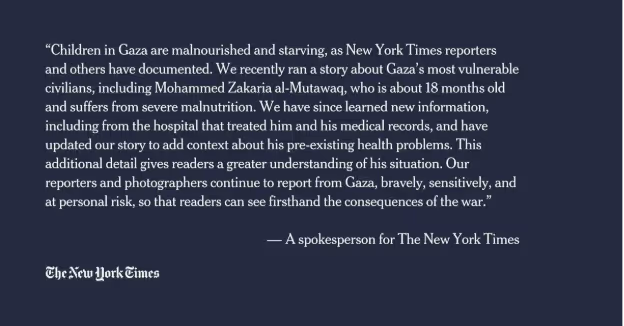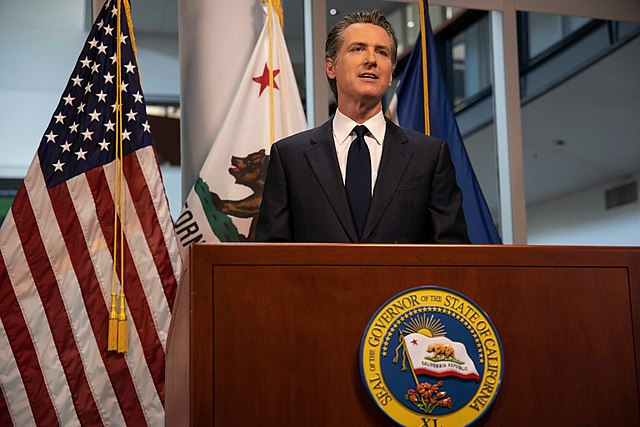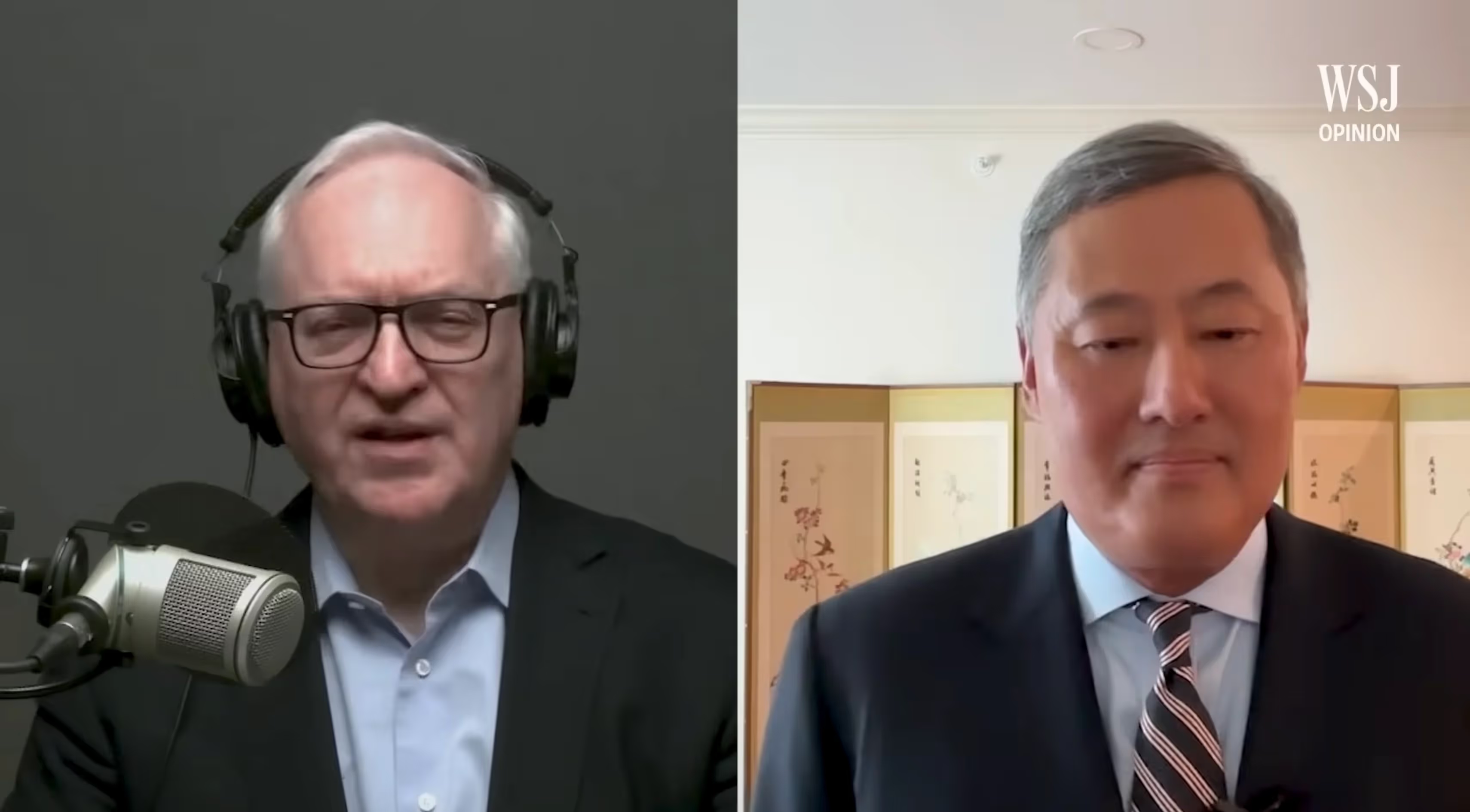
Defamation Comes to the Gaza Strip
An explosive New York Times photograph will precipitate a world-wide legal war.
Amid all the fury and controversy over the erratic supply of food to beleaguered Palestinians in Gaza comes a picture so powerful and so flawed from the New York Times that it is likely to generate a tsunami of lawsuits from Israel, seeking billions. The source of the controversy is this picture, which was first printed in the New York Times and then circulated throughout the world “in major outlets like CNN, Sky News, The Guardian, Daily Mail, The Times and BBC, as well as the pro-Israel Daily Express.”
This photograph, taken by the Gazan journalist Ahmad al-Arini, showed a gaunt 18-month-old boy, Mohammed Zakaria al-Mutawaq, whose diaper was a black garbage bag. The story’s print headline read: “Young, Old and Sick Starve to Death in Gaza: ‘There Is Nothing.’” The Times story continued that the child’s mother said that the child “was born healthy but was recently diagnosed with severe malnutrition.” The global message was that his perilous condition was a direct consequence of an Israeli campaign to starve out Gaza as part of the plan to remove Hamas from Gaza. The catch, revealed by the investigative reporter David Collier, was that the boy had suffered from birth from rare genetic disorders, including both cerebral palsy and chronic low-level diseases, which are profound in themselves, but which present additional challenges during wartime. The impact of this picture caused massive public outcry worldwide which generated large amounts of anti-Israel sentiment. These reputational losses are involved in many defamation cases, where they are hard to quantify in monetary terms. Indeed, they are all too real whenever defamation can lead to a loss of business customers, an election, a marriage, and massive political repercussions. But here the stakes are far higher as these messages can lead to acts of violence against Israel, its citizens, and indeed Jews all around the world. Given this background, the New York Times knew that it could not defend that damning picture on the merits and several days later posted this statement on X:
We have appended an Editors’ Note to a story about Mohammed Zakaria al-Mutawaq, a child in Gaza who was diagnosed with severe malnutrition. After publication, The Times learned that he also had pre-existing health problems. Read more below.

That post did nothing to stop the fury, and its evasive tone may have intensified it. So there is speculation everywhere about the strength of the case that Israel might bring to deal with the situation. The New York Sun cautioned that
Any defamation lawsuit would face significant legal hurdles. Per the law, the Israeli government would need to prove the Times published false statements with “actual malice” — meaning that they knew the information was false but chose to share it anyway — and demonstrate that they sustained reputational damage.
Amen, but. To be sure, all defamation suits are tricky, and this one will be no exception. Nonetheless, I have never encountered, in over fifty years of working in the area, any situation where the chips are all stacked on the plaintiff’s side. The first point has to do with the “actual malice” standard set out in New York Times v. Sullivan (1964), which requires that the defendant act with knowledge of falsehood or reckless disregard of the truth. There, an Alabama Commissioner of Public Affairs was stripped of $500,000 from a local jury, where the Times had published an advertisement run by civil rights groups against the Alabama police commissioner that contained arguably false information, which the Times only published for an ad fee before a tiny Alabama readership of under 400, out of a total circulation of 650,000 for its Sunday edition. In contrast, here there is a front-page news story that reached hundreds of millions of people, prepared by Times employees, based on information that it had received from its own sources.
It does not help the Times that it has long been attacked for biased reporting in Gaza, but the real risk to the New York Times lies elsewhere. The absolute malice standard works wonders for defendants in the ordinary cases of sloppy reporting. They can properly plead that they were merely negligent because they did not know of the falsehood. But in a routine defamation case, if the plaintiff can establish malice, it has the opposite effect. It shows that the case should not be treated as one of inadvertence but of deliberate falsehood, which increases the potential award for actual damages, opens the door to punitive damages, and necessarily allows the plaintiffs to gain access to the defendant’s files to gather the evidence needed to either establish or bolster the claim of malice. In this case, given the sensitivity of the story, opening its books and records could only hurt the Times further. In cases of this sort, malice operates as a multiplier of liability, not as a defendant’s bulwark.
The evidence here shakes out badly for the Times. Thus, it is likely that the plaintiffs will be able to show that the Times knew that the story was false at the time it was published, as is furiously alleged by Naftali Bennett in denouncing the blood libel, by saying: “NYT, you knew that Hamas uses babies with preexisting illnesses. We’ve been saying this for months now.” Indeed, Collier reported that the cropped photo did not show Mohammed’ healthy three-year old brother, Jude, which, if known by the Times when it published the photo, would knock the legs out from its denial of absolute malice. Even if somehow it did not know, the Times still faces a high risk of its reckless disregard of the truth.
The situation gets worse for the Times given its evasive actions after the story first broke. Look again at the response of the New York Times. As a general matter, a retraction will mitigate damages and undercut a claim of malice only if it is published with the same level of publicity as the original story. But the New York Times did not issue a retraction but only an addendum, which it published on an auxiliary site where the viewership is 89.000, but not on its main site, where it reaches some 55 million viewers. The story claims that the Times only learned about this matter after the story was published, which may well have been false. Hence, the Times’ sketchy handling of the follow-up may well increase its liability by showing continued evasion of its responsibility, using a strategy of publishing widely and taking it back quietly. Its addendum had attracted 15.8 million viewers as of July 29, 2025.
The litigation morass, moreover, is not confined to the New York Times, given that other major media groups picked up the Times picture for their use in outlets in Great Britain and elsewhere. These diverse jurisdictions may or may not incorporate the American actual malice standard into their rules. But again, no matter what these doctrinal nuances are, the Israelis can allege that their close working relationship with the Times also taints them with actual knowledge, a bad fact, no matter what local law provides.
Nor will Israel face any insurmountable obstacle to damages. It is standard law as illustrated by the 1983 case of Brown & Williamson v. Jacobson (1983) that liability is per se (automatic), that plaintiffs can recover general damages based on a combination of both the nastiness of the allegations and the breadth of their dissemination, and that plaintiffs can recover special damages by showing particular instances of such losses, which here could include the decisions of Canada, England, France, and Germany to move toward recognizing a Palestinian state, or Trump’s condemnation from Scotland that “That’s real starvation. I see it, and you can’t fake that,” when it appears that sometimes you can.
Yet the Times, by way of defense, will find it easy to complicate matters in its effort to minimize the power of that statement by introducing its own evidence that points to Israeli misdeeds in blocking or failing to distribute aid in Gaza. But once it does so, the pendulum swings back so that the Israelis can also introduce evidence that Hamas and the United Nations, through UNRWA (the United Nations Relief and Works Agency for Palestine), which allegedly operates as an arm of Hamas, have all used the current media attacks on Israel as a reason to back off entering into a ceasefire with Israel, while refusing to help distribute the ample Israeli supplies waiting at the border for distribution in Gaza. It will not help the Times that in the background lies a determined effort by the Trump administration to dismantle UNRWA as “irredeemably compromised,” which undercuts the credibility of any evidence that it offers. This giant tug-of-war will allow both sides to introduce and contest reams of evidence as to the proper context in which to place the publication of the photograph, but these barrels of information at best may only mitigate on the one side, and aggravate on the other, the indisputable harm that the photograph dealt. It is thus clear that this undisputed bombshell will allow for any trier of fact, whether a court or a jury, to award huge sums of damages in this case. And we know, at least in the United States, more knives were sharpened when Trump secured a $16 million settlement against Paramount on an iffy claim that CBS had deceptively edited an interview by Bill Whitaker and Kamala Harris. With that baseline, the sky’s the limit in Israel v. New York Times.
Richard A. Epstein is a senior research fellow at the Civitas Institute. He is also the inaugural Laurence A. Tisch Professor of Law at NYU School of Law, where he serves as a Director of the Classical Liberal Institute, which he helped found in 2013. Epstein is also the James Parker Hall Distinguished Service Professor of Law Emeritus and a senior lecturer at the University of Chicago.
Politics
.webp)
Liberal Democracy Reexamined: Leo Strauss on Alexis de Tocqueville
This article explores Leo Strauss’s thoughts on Alexis de Tocqueville in his 1954 “Natural Right” course transcript.
%20(1).avif)
Long Distance Migration as a Two-Step Sorting Process: The Resettlement of Californians in Texas
Here we press the question of whether the well-documented stream of migrants relocating from California to Texas has been sufficient to alter the political complexion of the destination state.
%20(3).avif)
Who's That Knocking? A Study of the Strategic Choices Facing Large-Scale Grassroots Canvassing Efforts
Although there is a consensus that personalized forms of campaign outreach are more likely to be effective at either mobilizing or even persuading voters, there remains uncertainty about how campaigns should implement get-out-the-vote (GOTV) programs, especially at a truly expansive scale.

California job cuts will hurt Gavin Newsom’s White House run
California Governor Gavin Newsom loves to describe his state as “an economic powerhouse”. Yet he’s far more reluctant to acknowledge its dramatically worsening employment picture.

An anti-woke counter-revolution is sweeping through the media
From Hollywood to the newsroom, the hegemony of the ‘progressives’ is finally faltering.

What Adam Smith’s Justice Teaches Us About Stealing Benefits
There is a constant tension in liberal systems between the shared trust necessary for the system's survival and the use of public entitlements paid for at public expense.

The Family Policy Symposium
How should we approach the problems of family formation and fertility decline in America?
.avif)



%20(1).jpg)









